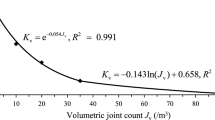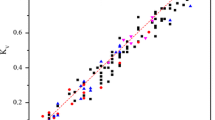Abstract
To confirm the robustness of a tunnel, the quality of the rock mass is usually evaluated by several rock mass classification (RMC) systems before its design. Besides, the accuracy of the RMC should be checked through the correlations between different RMC systems. The relationship between the different RMC systems and P-wave velocity indexes is conducive to the interpretation of the rock mass. Here, based on linear or nonlinear regression analysis of 231 samples, we established the RMR–Q, [BQ]–Q, and [BQ]–RMR relationships with R2 = 0.935, 0.732, and 0.759, respectively. Further analysis showed that the grading differences between any two RMC systems yield different characteristics when the rock mass score is at different intervals. To evaluate the relations between RMC indexes and P-wave velocity, we conducted a group study on the different grading differences among RMR, Q, or BQ. Depending on the consistency of the grading results, we arranged the values from large to small as the amplitude of the slope of the curve, and the grading results differed by either one or two levels. Our data demonstrated that the grading differences between the systems are proportional to the discontinuous state of rock mass in the classification. In addition, the classification results of Q, RMR, and BQ showed more significant differences when less consideration is given to the integrity of the rock mass.














Similar content being viewed by others
References
Fang Q, Zhang D, Zhou P, Wong LNY (2013) Ground reaction curves for deep circular tunnels considering the effect of ground reinforcement. Int J Rock Mech Min 60:401–412. https://doi.org/10.1016/j.ijrmms.2013.01.003
Liu Z, Dang W (2014) Rock quality classification and stability evaluation of undersea deposit based on M-IRMR. Tunn Undergr Sp Tech 40:95–101. https://doi.org/10.1016/j.tust.2013.09.013
Warren SN, Kallu RR, Barnard CK (2016) Correlation of the rock mass rating (RMR) system with the unified soil classification system (USCS): introduction of the weak rock mass rating system (W-RMR). Rock Mech Rock Eng 49(11):4507–4518. https://doi.org/10.1007/s00603-016-1090-1
Jorda-Bordehore L (2017) Stability assessment of natural caves using empirical approaches and rock mass classifications. Rock Mech Rock Eng 50(8):2143–2154. https://doi.org/10.1007/s00603-017-1216-0
Zhang Q, Huang X, Zhu H, Li J (2019) Quantitative assessments of the correlations between rock mass rating (RMR) and geological strength index (GSI). Tunn Undergr Sp Tech 83:73–81. https://doi.org/10.1016/j.tust.2018.09.015
Yu L, Zhang D, Fang Q, Cao L, Xu T, Li Q (2019) Surface settlement of subway station construction using pile-beam-arch approach. Tunn Undergr Sp Tech 90:340–356. https://doi.org/10.1016/j.tust.2019.05.016
Bieniawski ZT (1974) Engineering classification of jointed rock masses. Int J Rock Mech Min 11(5):98. https://doi.org/10.1016/0148-9062(74)90924-3
Barton N, Lien R, Lunde J (1974) Engineering classification of rock masses for the design of tunnel support. Rock Mech 6(4):189–236. https://doi.org/10.1007/BF01239496
GB 50218-2014 (2014) Standard for Engineering Classification of Rock Mass. Ministry of Housing and Urban-Rural Development of the People’s Republic of China, Beijing (in Chinese)
Choi SY, Park HD (2002) Comparison among different criteria of RMR and Q-system for rock mass classification for tunnelling in Korea. Tunn Undergr Sp Tech 17(4):391–401. https://doi.org/10.1016/S0886-7798(02)00063-9
Laderian A, Abaspoor MA (2011) The correlation between RMR and Q systems in parts of Iran. Tunn Undergr Sp Tech 27:149–158. https://doi.org/10.1016/j.tust.2011.06.001
Bieniawski ZT (1985) Rock mechanics design in mining and tunneling. Int J Rock Mech Min 22(3):193–194. https://doi.org/10.1016/0148-9062(85)93235-8
Barton N, Bieniawski ZT (2008) RMR and Q - Setting Records Straight. Tunnels & Tunnelling International, pp 26–29. https://www.researchgate.net/publication/290087135
Hashemi M, Moghaddas Sh, Ajalloeian R (2010) Application of rock mass characterization for determining the mechanical properties of rock mass: a comparative study. Rock Mech Rock Eng 43(3):305–320. https://doi.org/10.1007/s00603-017-1199-x
Sayeed I, Khanna R (2015) Empirical correlation between RMR and Q systems of rock mass classification derived from Lesser Himalayan and Central crystalline rocks. In: Proceeding of the International Conference on Engineering Geology in New Millennium. Journal Engineering of Geology, New Delhi. https://www.researchgate.net/profile/Rahul-Khanna-2/publication/283497675_Empirical_correlation_between_RMR_and_Q_systems_of_rock_mass_classification_derived_from_Lesser_Himalayan_and_Central_crystalline_rocks/links/563b2dab08ae405111a5e869/Empiricalcorrelation-between-RMR-and-Q-systems-of-rock-mass-classification-derived-from-Lesser-Himalayan-and-Central-crystalline-rocks.pdf
Fernández-Gutiérrez JD, Perez-Acebo H, Mulone-Andere D (2017) Correlation between Bieniawski’s RMR index and Barton’s Q index in fine-grained sedimentary rock formations. Inf Constr 69:e205. https://doi.org/10.3989/id54459
Rehman H, Ali W, Naji AM, Kim J, Abdullah RA, Yoo H (2018) Review of rock-mass rating and tunneling quality index systems for tunnel design: development, refinement, application and limitation. Appl Sci-Basel 8(8):1250. https://doi.org/10.3390/app8081250
Yan R, Shen Y (2015) Correlation of revised BQ System in China and the international rock mass classification systems. J Civ Eng Res 5(2):33–38. https://doi.org/10.5923/j.jce.20150502.03
Bery AA, Rosli S (2012) Correlation of seismic P-wave velocities with engineering parameters (N value and rock quality) for tropical environmental study. Int J Geosci 3(4):749–757. https://doi.org/10.4236/ijg.2012.34075
Cha YH, Kang JS, Jo CH (2006) Application of linear-array microtremor surveys for rock mass classification in urban tunnel design. Explor Geophys 37(1):108–113. https://doi.org/10.1071/EG06108
Zafirovski Z, Peševski I, Papić J (2012) Methodology for extrapolation of rock mass deformability parameters in tunneling. Facta Univ Ser Archit Civ Eng 10(3):235–244. https://doi.org/10.2298/fuace1203235z
Nourani MH, Moghadder MT, Safari M (2017) Classification and assessment of rock mass parameters in Choghart iron mine using P-wave velocity. J Rock Mech Geotech 9(2):318–328. https://doi.org/10.1016/j.jrmge.2016.11.006
Barton N (2002) Some new Q-value correlations to assist in site characterisation and tunnel design. Int J Rock Mech Min 39(2):185–216. https://doi.org/10.1016/S1365-1609(02)00011-4
Assim A, Xing ZY (2010) Most used rock mass classifications for underground opening. Am J Eng Appl Sci 3(2):403–411. https://doi.org/10.3844/ajeassp.2010.403.411
Grimstad E, Barton N (1993) Updating of the Q system for NMT. In: Proceedings of the International Symposium on Sprayed Concrete-Modern Use of Wet Mix Sprayed Concrete for Underground Support. Norwegian Concrete Association, Oslo. https://www.researchgate.net/publication/284818046
GB 50218-94 (1995) Standard for Engineering Classification of Rock Masses, Ministry of Housing and Urban-Rural Development of the People’s Republic of China, Beijing (in Chinese)
Abad J, Celada B, Chacon E et al (1984) Application of geomechanical classification to predict the convergence of coal mine galleries and to design their supports. Int J Rock Mech Min 21(5):A181. https://doi.org/10.1016/0148-9062(84)92847-x
Al-Harthi AA (1994) Application of CSIR and NGI classificationsystems along tunnel no. 3 at Al-Dela Descent, Asir Province,Saudi Arabia: proc 26th annual conference of the engineering group of the geological society, the engineering geology of weak rock. Int J Rock Mech Min Sci Geomech Abstr 31(2):A86. https://doi.org/10.1016/0148-9062(94)93011-2
Bieniawski ZT (1977) Exploration for rock engineering. Volume 1 of the Proceedings of the symposium on exploration for rock engineering, Johannesburg, 1–5 November, 1976. Int J Rock Mech Min Sci Geomech Abstr 14(3):161–162. https://doi.org/10.1016/0148-9062(77)90010-9
Cameron-Clarke LS, Budavari S (1981) Correlation of rock mass classification parameters obtained from bore core and in–situ observations. Eng Geol 17:19–53. https://doi.org/10.1016/0013-7952(81)90019-3
Kaiser PK, MacKay C, Gale AD (1986) Evaluation of rock classifications at B. C. Rail tumbler ridge tunnels. Rock Mech Rock Eng 19:205–234. https://doi.org/10.1007/BF01039996
Kumar N, Samadhiya NK, Anbalagan R (2004) Application of rock mass classification system for tunneling in Himalaya, India. Int J Rock Mech Min 41(3):531. https://doi.org/10.1016/j.ijrmms.2003.12.117
Tuğrul A (1998) The application of rock mass classification systems to underground excavation in weak limestone, Ataturk dam, Turkey. Eng Geol 50(3–4):337–345. https://doi.org/10.1016/s0013-7952(98)00034-9
Goel RK, Jethwa JL, Paithankar AG (1996) Correlation between Barton’s Q and Bieniawski’s RMR—a new approach. Int J Rock Mech Min 33(2):179–181. https://doi.org/10.1016/0148-9062(95)00057-7
Yan T, Wu X, Wu L (2009) Correlation study on surrounding rockmass classification for underground cavern and its application. Chin J Undergr Sp Eng 5(6):1103–1108 ((in Chinese))
Shang J, Hencher SR, West LJ (2016) Tensile strength of geological discontinuities including incipient bedding, rock joints and mineral veins. Rock Mech Rock Eng 49(11):4213–4225. https://doi.org/10.1007/s00603-016-1041-x
Zhang D, Fang Q, Lou H (2014) Grouting techniques for the unfavorable geological conditions of Xiang’an subsea tunnel in China. J Rock Mech Geotech 6(5):438–446. https://doi.org/10.1016/j.jrmge.2014.07.005
Ramamurthy T, Latha GM, Sitharam TG (2017) Modulus ratio and joint factor concepts to predict rock mass response. Rock Mech Rock Eng 50(2):353–366. https://doi.org/10.1007/s00603-016-1112-z
Acknowledgements
The authors gratefully acknowledge the National Natural Science Foundation of China (Grant 51738002) and the financial support by the National Key R&D Program of China under Grant 2017YFC0805401.
Author information
Authors and Affiliations
Corresponding author
Ethics declarations
Conflict of interest
The authors declare that they have no conflict of interest.
Rights and permissions
About this article
Cite this article
Xu, T., Zhang, D., Li, A. et al. Dissecting the Robustness of the Rock Mass Classification Methods Used in Jiaozhou Bay Subsea Tunnel. Int J Civ Eng 19, 1473–1482 (2021). https://doi.org/10.1007/s40999-021-00625-9
Received:
Revised:
Accepted:
Published:
Issue Date:
DOI: https://doi.org/10.1007/s40999-021-00625-9




